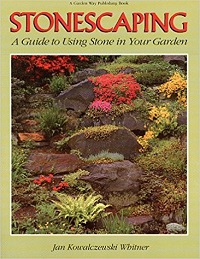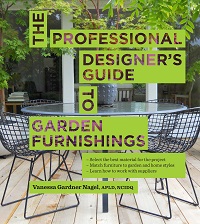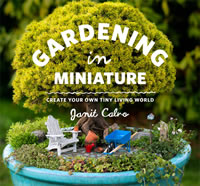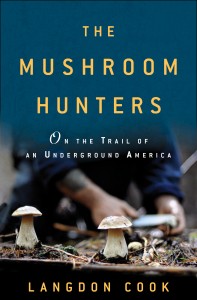
Two traits stand out in Jan Kowalczewski Whitner’s collected writings: her passion for stonework and her considerable skill at using words to describe a garden. Both are apparent in her first book from 1992, “Stonescaping.” Also apparent is her training as an historian as she expertly traces the history of stone in gardens as it has been used in Chinese, Japanese, and European traditions. She then presents simple but engaging descriptions of home-scale gardens that adapt and meld these traditions.
This would be plenty to fill the first book by most authors, but Jan had more to offer. She continued with an extensive practicum on building everything from stone hardscapes to rock gardens and even hypertufa birdbaths. This combination of history, design, and construction is what makes this book so unusual.
One paragraph from the chapter on rock gardens demonstrates this synergy. “If you have a flat site on which you wish to build a rock garden, use a construction technique first developed by ancient Chinese gardeners to introduce different levels to the composition by digging out low areas and then mounding the excavated earth into ridges and plateaus above them. Use half-buried, weathered stones to replicate outcrops, and work from the bottom of the rock garden toward the top.”
Excerpted from the Summer 2014 Arboretum Bulletin.

“The Professional Designer’s Guide to Garden Furnishings” by Portland Landscape Designer Vanessa Gardner Nagel identifies its primary audience in the title, but there’s much here for the discriminating homeowner, too. Especially valuable are the detailed, chapter-length analyses of the many materials that can be used in furnishings, including wood, metal, textiles, and even wicker, glass, or stone. Each chapter includes the industry standards for high quality, finishing options, best maintenance practices, and the sustainability of each material.
The author is at her best when—after carefully presenting a concept—she explains how she will bend the rules. In a section from “Furnishings” on Scale and Proportion, she states, “The old concept of small things in a small space simply isn’t true. A couple of large objects in a small space can work splendidly…” and she goes on to explain why this works.
Excerpted from the Spring 2014 Arboretum Bulletin.

“Understanding Garden Design,” by Portland-based landscape designer Vanessa Gardner Nagel(published in 2010) is so well organized and structured it could easily be used as a textbook, but that may unfortunately imply dullness to what is a very readable and engaging book.
To get the best out of this book, however, the author does expect work on the part of the reader, leading you through the steps that a professional designer would follow. Much of this work is required before you reach the fun part of choosing plants. These aren’t discussed until Chapter 8, and then only as elements of structure, using the analogy of punctuation to describe the different selections (some plants are commas, others are parentheses, etc.).
Building with each chapter is a hypothetical garden design using the principles discussed that effectively ties all the concepts together. Even if you decide to hire a designer, this book will help you speak and understand the language and be better at expressing your desires. You will also find very useful a whole chapter on working with contractors.
Excerpted from the Spring 2014 Arboretum Bulletin.

As a boy, I did not embrace the hobby of making models. Yes, I had a train set, but no desire to create a world of villages, forests, and the like to surround the tracks. Instead, I wanted to be outside in the garden and working with full-sized plants.
This makes me feel a bit inadequate to review “Gardening in Miniature” by Seattleite Janit Calvo. However it turns out that at its heart, this is a gardening book, with sound design advice and cultural tips, just all at 1:12 (one inch = one foot) scale, or even smaller.
“Using the basic garden tenets of anchor point, balance, layers, texture, color, and focal point, you can plan your miniature garden with confidence,” the author states encouragingly. Step-by-step, fully planned projects provide lots of guidance for the beginner. I worried that plants would not stay to scale, and indeed they might not, but it’s easy to swap plants in and out.
I learned from this that while there is some overlap in principles and techniques between miniature gardening and bonsai, they are largely distinct pursuits. However, they can be combined by making a bonsai the centerpiece of your miniature garden. Will I take up miniature gardening? Probably not. But my eyes have been opened to a whole new–and quite small–world.
Excerpted from the Spring 2014 Arboretum Bulletin.

Constance Sidles has written her third book of essays and observations on the Union Bay Natural Area titled “Fill of Joy: More Tales from Montlake Fill”. Like her previous books, this includes many excellent photographs and other artistic interpretations of the site (in paintings, poetry, and even dance) and an updated bird list, now counting 255 species recorded since the 1890s.
The heart of the book remains Connie’s self-deprecating humor and philosophies about life. While the bird life is her focus, she spots humans and other visitors, too. “When the joggers wheeze by they smile and say hello. I don’t know their names, but I know them. The dog walkers who keep their dogs leashed stop to chat while I ruffle their friends’ ears; the dog walkers who let their dogs run free usually head the other way “my gimlet eyes are giving them the Look.”

“Backyard Roots” is a collection of vignettes about urban dwellers motivated to have a closer connection to their food and their communities. There are many ways to do this, and the strength of this book is its breadth of inspiring ideas that have already been realized. Making it even better, the individuals and families profiled all live on the West Coast, from British Columbia to northern California.
Author/photographer Lori Eanes has a career in food photography and her original intent was a photo essay but, she says in her introduction, “as I learned people’s stories their dedication inspired me to write about them too.” While the writing is good, her camera is particularly effective at bringing out her subjects’ personalities–both human and animal.
While some of the topics, such as raising ducks or goats, are addressed in detail in other books, there are several more adventuresome projects. These include raising tilapia in an aquaponic garden and grafting food fruits onto ornamental street trees, guerrilla style. I gave a copy as a Christmas gift and I recommend it highly, especially to anyone with the spirit and resourcefulness of a homesteader.
Excerpted from the Winter 2014 Arboretum Bulletin.

In “The Mushroom Hunters,” Seattle author Langdon Cook asks what professional foragers get for their efforts: “An itinerant life on the road, continually moving with the seasons? A low hourly wage and no chance for health insurance? A garden variety of potential wilderness pitfalls, including injury, exposure, even wild animals?”
The answer is: all of the above, but that doesn’t stop this from being a very big business. The collectors, those who buy from collectors, the distributors, and even the celebrity chefs who are at the top of this commercial food chain weave in and out of these pages much like in a high-energy, first-person novel. The settings, from the Yukon to California are evocative, too, but mostly somewhat vague–the secret locations of valuable hunting grounds are not to be shared.
This is Cook’s second book on foraging. The Miller Library also has “Fat of the Land” from 2009. In addition to mushrooms, this book highlights the collection practices for fiddlehead ferns, dandelions, huckleberries, and a selection of animals including clams, crabs, and various fish. Several recipes will set your mouth watering.
 Melany Vorass Herrera is an enthusiastic and experienced forager who lives in Seattle. In “The Front Yard Forager” she identifies 30 common weeds found in North American cities that she recommends we add to our regular diet. I found her presentations, including recipes, beguiling–especially as my own garden is filled with several of her selections that until now I’ve tossed into yard waste.
Melany Vorass Herrera is an enthusiastic and experienced forager who lives in Seattle. In “The Front Yard Forager” she identifies 30 common weeds found in North American cities that she recommends we add to our regular diet. I found her presentations, including recipes, beguiling–especially as my own garden is filled with several of her selections that until now I’ve tossed into yard waste.
Before heading to the garden or the vacant lot, however, the author has several cautionary topics to consider to keep you–the foraging consumer–safe and to ensure your collecting doesn’t disrupt the ecology or social harmony of the neighborhood. Further caveats fill each plant entry, including “Poisonous Look-Alikes” and “Who Should Avoid It” warnings.
While most of the selections, such as dandelions (Taraxacum officinale), have general consensus in the literature as safe to eat, some of Vorass Herrera’s other choices are less certain. This makes as a good companion book the new edition of “The North American Guide to Common Poisonous Plants and Mushrooms” by two University of Victoria authors, Nancy J. Turner and Patrick von Aderkas.
The wild sweet pea (Lathyrus latifolius) illustrates the value of consulting at least these two sources before consuming any wild plant. Vorass Herrera recommends it when identification is certain and when eaten only in moderation. Turner and von Aderkas state that “all species of Lathyrus should be regarded with caution. However, a strong case is made for the edible qualities of wild sweet pea (L. latifolius) by wild food expert John Kallas.” A discussion of the arguments by Kallas follows, leaving you–the now well-informed forager–with three distinct opinions on the safety of putting this plant on your dinner table.
The importance of this is best summed up by Vorass Herrera: “The bottom line? A good forager needs to be willing to spend a little time digging for accurate information.”
Excerpted from the Winter 2014 Arboretum Bulletin.
 Richard Bitner has written three books about conifers in the garden; I think the best is the most recent, “Designing with Conifers.” Organized by notable features such as shape, color, or bark, the author uses his own photographs to illustrate a wide range of planting options. He clearly detests foundation plantings: “Why this mandatory dress code? It is time to break free of this tradition and change our practices.”
Richard Bitner has written three books about conifers in the garden; I think the best is the most recent, “Designing with Conifers.” Organized by notable features such as shape, color, or bark, the author uses his own photographs to illustrate a wide range of planting options. He clearly detests foundation plantings: “Why this mandatory dress code? It is time to break free of this tradition and change our practices.”
Specialty situations such as hedges and topiary are included, along with some unexpected chapters on recommended Christmas trees, dwarf cultivars for garden railways, and–the most curious–traditional plantings for German graveyards. Although the author is from the East Coast, I thought his best work was a case study of a garden near Eugene, with a photographic dissection of the different purposes for the plants used in the landscape–quite instructive.
![[Conifers of the World] cover](https://depts.washington.edu/hortlib/graphix/ConifersoftheWorld.jpg)
James Eckenwalder graduated from Reed College in Portland, making him a one-time Pacific Northwest resident, although he is now on the faculty at the University of Toronto. “Conifers of the World: The Complete Reference” is an ambitious effort that was years in the making. It is an excellent reference book in a single volume.
Tropical species are given equal treatment to temperate and the A-Z presentation emphasizes descriptive text–there are only a few photos and those are mostly in black and white. The introduction includes a very readable discussion of taxonomy; the author is clearly captivated by the subject but is able to make his points in terms for a general audience. “My overriding motivation behind all of these considerations, however, is to share my fascination and enthusiasm for these wonderful plants.”







 Melany Vorass Herrera is an enthusiastic and experienced forager who lives in Seattle. In
Melany Vorass Herrera is an enthusiastic and experienced forager who lives in Seattle. In  Richard Bitner has written three books about conifers in the garden; I think the best is the most recent,
Richard Bitner has written three books about conifers in the garden; I think the best is the most recent, ![[Conifers of the World] cover](https://depts.washington.edu/hortlib/graphix/ConifersoftheWorld.jpg)